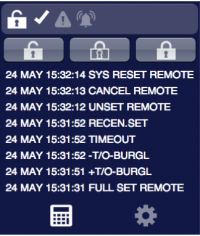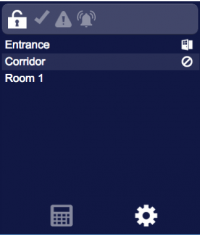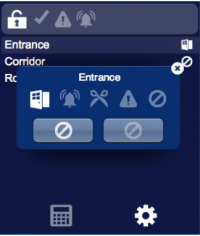Difference between revisions of "Galaxy"
| Line 416: | Line 416: | ||
=== USER Commands === | === USER Commands === | ||
| + | The Galaxy I/O Server supports a few system commands to be inserted within the Web interface. The controls are directly supported as ordinary [[user]] objects, by setting the ''name'' and ''param'' fields according to the following table: | ||
{| class="wikitable" | {| class="wikitable" | ||
Revision as of 11:19, 19 February 2014
The Honeywell Galaxy Dimension panels are multi-area intrusion detection systems. The integration with HSYCO can be accomplished via RS-232 serial communication.
Contents
Communication
Employ a RS-232 straight cable to connect the panel directly to HSYCO or to an Ethernet/RS-232 gateway.
RS-232 parameters:
| Baud rate | 9600 |
| Data bits | 8 |
| Stop bit | 1 |
| Parity | none |
| Flow control | none |
Galaxy Configuration
It is required to configure the panel for HSYCO to be able to communicate with it. Follow these instructions:
- Enable the engineer access
- Menu 48.1.1 - set to 1 (Enabled)
- Enable engineer mode
- Enter engineer PIN, followed by ENT
- Enable remote access and events reporting
- Menu 56.6.2 - set to 1 (SIA)
- Set SIA level to 4
- Enable (set to ON) all the events to be sent to HSYCO
- Menu 56.6.3 - set an account number (e.g. “0001”)
HSYCO Configuration
Options
| ID | Default | Values | Description |
|---|---|---|---|
| pin | <code> | PIN code assigned to the “remote” user. This option is mandatory | |
| maxzone | 4158 | 0 ... 4158 | highest zone number among the zones used on the panel. This option is recommended to improve the I/O Server's performances |
| maxgroup | 32 | 0 ... 32 | highest index among the groups used on the panel. This option is recommended to improve the I/O Server's performances |
| maxoutput | 256 | 0 ... 256 | highest index among the outputs used on the panel. This option is recommended to improve the I/O Server's performances |
| guiobject | true | true | enable support for the galaxy UI object |
| false | disable support for the galaxy UI object | ||
| guizones | false | true | enable the zones-related UISET actions |
| false | disable the zones-related UISET actions | ||
| guioutputs | false | true | enable the outputs-related UISET actions |
| false | disable the outputs-related UISET actions | ||
| startupevents | false | true | generate IO events also during the driver’s start-up phase |
| false | start generating events only after HSYCO is aligned with the current status of the system | ||
| pollinterval | 5 | n > 0 | the data acquisition interval, in seconds |
| logsize | 20 | n ≥ 0 | the number of log lines to display in the UI object |
| showall | false | true | in the zones list of the galaxy UI object show all the zones up to the number specified in the 'maxzone' option |
| false | in the zones list of the galaxy UI object show only the zones for which a name has been defined in galaxy.ini |
galaxy.ini
The galaxy.ini file is a specific configuration file located in the root directory. Here you can define the names of the zones so that they will be automatically added to the user interface. Add a new line for each zone using this format:
<io_server_id>.z<n> = <name>
For instance:
gxy.z1001 = Entrance gxy.z1002 = Corridor gxy.z2001 = Room 1
Datapoints
| ID | Value | R/W | Description |
|---|---|---|---|
| connection | online | R | connection established |
| offline | R | HSYCO can't connect to the panel | |
| g<n>.armed | 0 | R | group <n> is disarmed |
| W | disarm group <n> | ||
| tot | R | group <n> is armed in “away” mode | |
| W | arm group <n> in “away” mode | ||
| part | R | group <n> is armed in “stay” mode | |
| W | arm group <n> in “stay” mode | ||
| abort | W | abort group <n> arming | |
| force | W | force group <n> arming | |
| g<n>.alarm | 0 | R | no active alarm on group <n> |
| 1 | R | alarm on group <n> | |
| reset | R | alarms reset required on group <n> | |
| g<n>.ready | 0 | R | group <n> is not ready to be armed |
| 1 | R | group <n> is ready to be armed | |
| g<n>.reset | 1 | W | reset alarms on group <n> |
| z<n>.open | 0 | R | zone <n> is closed |
| 1 | R | zone <n> is open | |
| z<n>.alarm | 0 | R | zone <n> is not in alarm |
| 1 | R | zone <n> is in alarm | |
| z<n>.bypassed | 0 | R | zone <n> is not bypassed |
| W | unbypass zone <n> | ||
| 1 | R | zone <n> is bypassed | |
| W | bypass zone <n> | ||
| z<n>.tamper | 0 | R | zone <n> is not tampered |
| 1 | R | zone <n> is tampered | |
| z<n>.fault | 0 | R | zone <n> is not in fault |
| 1 | R | zone <n> is in fault | |
| z<n>.masked | 0 | R | zone <n> is not masked |
| 1 | R | zone <n> is masked | |
| z<n>.resistance | 0 | R | zone <n> has normal resistance status |
| 1 | R | zone <n> has high or low resistance | |
| warning | 0 | R | all zones are working properly |
| 1 | R | at least one zone is in fault or is masked or has high or low resistance | |
| o<n>.active | 0 | R | output <n> is not active |
| W | deactivate output <n> | ||
| 1 | R | output <n> is active | |
| W | activate output <n> |
User Interface
Galaxy Object
The user interfacce for the Galaxy multi-area intrusion detection system:
The Galaxy object is listed in the Project Editor’s new object list only when at least one Galaxy I/O Server is defined.
Parameters
- server id: the server ID
- group number:
- position: the object's position. Use the pixels or rows and columns coordinates format
Syntax
(galaxy <server id>; <group number>; <position>)
E.g.
(galaxy serverid; group number; x10y20)
UISET Actions
You can use any object that accepts a text attribute, usually text, but also marquee and others, to display the status of the system according to the following table:
| ID | Attribute | Set to | |
|---|---|---|---|
| log | value | latest security log lines (as many as specified by the 'logsize' option) | |
| log0 | value | latest line of the security log when a new entry is added, set back to blank after a short period | |
| z<n>.name | value | name assigned to zone <n> or its number if no name is defined | |
| connection.label.online | visible | true | when datapoint connection = online |
| false | when datapoint connection = offline | ||
| connection.label.offline | visible | true | when datapoint connection = offline |
| false | when datapoint connection = online | ||
| <datapoint_id>.label.1 | visible | true | when datapoint with ID <datapoint_id> has value '1' |
| false | when datapoint with ID <datapoint_id> has value '0' | ||
| <datapoint_id>.label.0 | visible | true | when datapoint with ID <datapoint_id> has value '0' |
| false | when datapoint with ID <datapoint_id> has value '1' | ||
USER Commands
The Galaxy I/O Server supports a few system commands to be inserted within the Web interface. The controls are directly supported as ordinary user objects, by setting the name and param fields according to the following table:
| Name | Param | Action |
|---|---|---|
| g<n>.armed | 0 | disarm group <n> |
| tot | arm group <n> in “away” mode | |
| part | arm group <n> in “stay” mode | |
| abort | abort group <n> arming | |
| force | force group <n> arming | |
| g<n>.reset | 1 | reset alarms on group <n> |
| z<n>.bypassed | 0 | unbypass zone <n> |
| 1 | bypass zone <n> | |
| o<n>.active | 0 | deactivate output <n> |
| 1 | activate output <n> |
Log Files
A permanent detailed record of all the Galaxy log messages is saved in a file called security.log in the logs/YYYY directory for the current year. This file is never overwritten or deleted by HSYCO.
Other information related to the Galaxy I/O Server are saved in the daily message.log files.
Release Notes
3.3.0
- initial version release
Honeywell and Galaxy Dimension are registered trademarks of Honeywell International Inc.


